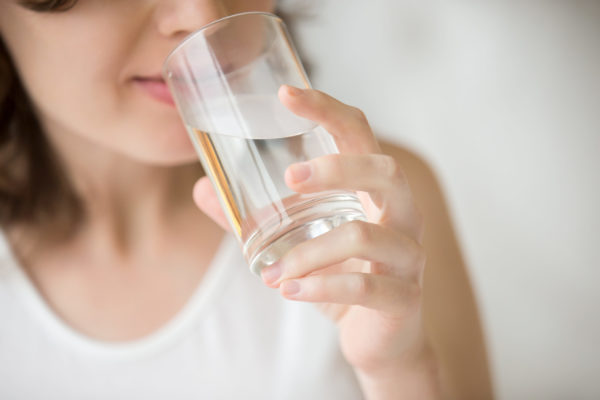What’s one source of toxicity in your daily routine that’s often overlooked? Your water. One would assume that since the government regulates tap water, it’s “safe” to consume. But unfortunately, this is not always the case. Find out below why you need a water filter, and what chemicals to steer clear of in your tap water.
Even if you’re mindful in every area of your daily health routine, overlooking your drinking water could lead to serious health issues.
Do You Need a Water Filter?
No matter which city or suburb you live in, chances are your water contains a few harmful toxins, heavy metals, or toxic chemicals. This is why it’s so important to have a water filter in your home.
While they may pass under the radar of federal exposure limits, a 2019 study from the EWG shows that even lower levels of these harmful contaminants in tap water can still prove very dangerous over time. The EWG states, “22 known carcinogens currently common in tap water could cumulatively result in over 100,000 cancer cases throughout a lifetime.”
Thankfully, testing your tap water for contaminants doesn’t take a lot of time. Learn how to test your water easily, and check out the water filters I recommend below.
How To Check Your Local Tap Water
- Find Your Local EWG water report online
The EWG is a non-profit organization that helps consumers gain transparency on what’s in your drinking water. Enter your zip code on EWG’s website to find the EWG report for your city/county water.
They will even show suggestions for water filtration. Note: their analysis doesn’t cover well water, so it’s critical for private well owners to test for a wide range of contaminants annually. - Order An In-Home Water Test Kit
Whether your home uses city tap water or well water, I recommend checking your household water with an in-home test kit. They are relatively inexpensive and available on Amazon. Here is my recommendation for testing the safety of your water at home.
The Top 11 Contaminants Found in Tap Water Across America
1 – Chloroform
Toxic to the nervous system, chloroform causes everything from respiratory issues to liver and kidney issues to depression. This toxic chemical enters water systems through the ground, and can also be an unwanted byproduct of chlorine that’s been added to a water system.
2 – Nitrate
According to the EWG, “Unlike virtually all other contaminant standards, the drinking water standard for nitrate contains no margin of safety.” High amounts of exposure can cause “blue baby syndrome” in infants, which is caused by a lack of oxygen in the blood.
3 – Atrazine
Tap water across the country contains this highly toxic weed killer that is classified as a Restricted Use Pesticide. Farmers commonly use Atrazine to spray corn and other crops. As a result, it seeps into groundwater through surrounding dirt.
Surveys of drinking water in rural domestic wells have detected trace amounts of atrazine that well surpass the EPA’s maximum concentration level. Europe banned this chemical in the 1980s, but the EWG found “more than 800 systems in 19 states at levels exceeding a health-protective guideline.”
4 – Hexavalent Chromium-6
Exposure to this chemical known as the “Erin Brockovich” chemical can create kidney and liver damage, eye irritation and damage, tumors, lung cancer, and other serious diseases. Unfortunately, this chemical has wreaked havoc thousands of families across the U.S. The extent of the damage is still being uncovered to this day.
According to the EWG test results, drinking water supplies for about 250 million Americans are contaminated with chromium-6.”
5 – Bisphenol (BPA)
Found in plastic containers and water bottles, BPA is a synthetic compound that can often seep into your water source and have negative effects on your body. According to Science Daily, “In the U.S. population, exposure [to BPA] is nearly ubiquitous, with 92.6 percent of persons 6 years or older identified…as having detectable BPA levels in their urine.”
You may notice that many products are now boasting the label “BPA Free” in efforts to reduce the risk of this synthetic compound. This may be due to the fact that many experts claim BPA mimics both the structure and function of the hormone estrogen. This means potential disruption to your bodily processes such as growth, cell repair, and reproductions, as well as interacting with your thyroid.
6 – “Forever” PFAS Chemicals
These are commonly used in nonstick products and military testing. They are known as “forever chemicals” because, once released into the environment, they do not break down, and they build up in our blood and organs. Exposure to PFAS increases the risk of cancer, harms the development of the fetus, and reduces the effectiveness of vaccines. Biomonitoring studies by the federal Centers for Disease Control and Prevention show PFA contamination in nearly everyone in the U.S.
7 – Arsenic
Did you know some industries in the United States release thousands of pounds of arsenic into the environment every year. This chemical is also a natually occuring element found in rock formations.
Studies show that long-term exposure to arsenic in drinking water can cause cancer in the skin, lungs, bladder, and kidney. Moreover, people ingesting high amounts of arsenic in drinking water reportedly are at an increased risk of lung and bladder cancer and skin changes.
8 & 9 – Uranium and Radium
Uranium and radium are radioactive materials that occur naturally in the ground and leach into your water through the soil. Uranium is toxic to human kidneys, and has been shown to cause bone and liver cancer. Radium is equally as harmful. While only 20% of radium absorbs into the body (the rest is passed through the gut), residual radium may cause cancer, birth defects, and kidney damage.
10 & 11 – Mercury and Lead
These heavy metals are toxic to the human body, even in short-term exposure. According to the EWG, “Mercury is a potent neurotoxin that also damages the kidneys and other internal organs. Mercury enters drinking water from industrial pollution, mining wastes and coal-fired power plants.” In addition, lead is also a heavy metal to be aware of.
Some cities have taken action by removing lead from their water pipes. However, some tap water still contains prevalent amounts of heavy metals. As stated by the EWG, “Lead is a potent neurotoxin that impairs children’s intellectual development and alters their behavior and ability to concentrate.”
This is why choosing a filter that removes these heavy metals proves so crucial. There are amazing water filters on the market that will help keep your family’s exposure to harmful chemicals and heavy metals such as these to a minimum. (See which filters I suggest below.)
Disclosure: Thank you for reading and sharing my content! The suggested products are ones that my family and I would also use, but I may collect a small commission on purchases made through some of the affiliate links on this page.
How To Choose A Water Filter
Once you test your household tap water, what’s next? A lot of people reach for Brita water filters or other activated carbon-based filters. And while they do filter some contaminants out, many toxic chemicals still remain. For example, some carbon-based filters can decrease PFAs (mentioned above), but not eliminate them completely.
When choosing a water filter, I recommend purchasing a reverse osmosis filtration system. They provide the highest level of filtration. They also have the added benefit of leveling the pH balance of the water to an alkaline state.
The above chart from the EWG provides an example of the toxins the three most common types of water filters remove (and the ones they don’t). I chose this example from the EWG because it shows the toxins present in Nashville tap water (where Josh and I live).
If your budget allows for it, I suggest getting a water filter that filters water for your entire home. For example, I love pH Prescription water filters because they offer complete home reverse osmosis systems.
If that’s not in your budget, there are more affordable options. For example, there are also great water filter options for under the sink, and even water filters that sit on your countertop.
My favorite countertop water filters are Berkey Filters reverse osmosis water filters. To get a 10% off discount, go to Berkey Filters enter the discount code CLEANWATER10 at checkout.
Beware of “Filtered” Bottled Water
While it’s an option in a pinch, it’s best to not rely on its safety. Research shows plastic water bottles can become contaminated when exposed to heat. Remember the chemical I mentioned, BPA? Many water bottles are made with this synthetic compound and when exposed to heat, high amounts of this chemical can seep from plastic bottles into your water.
Also, sometimes labels prove deceptive. According to the National Resources Defense Council, an estimated 25 percent of bottled water is merely tap water. Even more concerning? 22 percent of the brands they tested contained contaminant levels above state health limits.
Help Support Other Communities Without Clean Water
We can’t live without clean water. And yet more than 785 million people do. In America, millions live without running water, drinking water, and indoor plumbing. As you become more aware of your family’s drinking water, I encourage you to consider supporting non-profit clean water organizations like Charity Water.
You can submit a one-time donation or set up a monthly donation to help build safe water wells for families who are without clean water.






Hey! I’ve been wanting to learn more about this lately, so thank you.
Do you know anything about charcoal filters?
Or have any student budget suggestions?
Thanks!
Anscһließstop überträgt er sie auf deine Finances.